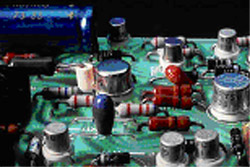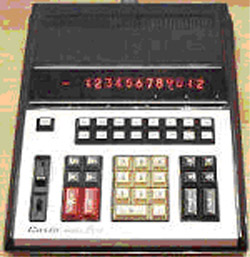Binary Data Storage and Manipulation
Demonstrating Physical Representation and Implementation |
|
|
::Binary and Electricity::
The number systems discussed under the History section were originally implemented via mechanical means, as previously discussed.
It is the electronic implementation of the binary number system and arithmetic that leads to modern computing.
Some of the early developments in this area are highlighted below.
Transistors
The field of electronics was dependent on the use of thermionic vacum tubes, and the introduction of transistors allowed for many advantages and improvements.
A transistor is capable of performing many functions of these vacuum tubes; it is a a device consisting of a tiny piece of semiconducting material, to which three or more electrical connections are made.
In addition to the ease of mass production, transitors provided more space in physical construction and also allowed for quicker computation.

Electromechanical Calculators
First electromechanic calculation machine developed at Harvard University called the Mark 1.
The Mark 1 was capable to the four basic operations, square roots, and the logartithm, exponential and trigonometric calculus.
The machine is guided by a series of instructions, which are represented by holes on a paper band or on punch cards or by an interpreter operated on by hand.
The mahcine goes on autonomous and gives the output, punching it on cards or printing through the electric typewriters.
The machine is composed of 78 calculation machines connected by 800 kilometers of electric wires and contains more than 3000 relays.

First generation IBM
In the early 1950's, IBM created a series of machines which were able to set one million binary digits.
The first generation's calculation machines are based on three basic functions: the input of the information, its elaboration, and the output of the elaboration.
The use of punch cards was still implemented, and once read by an intake unit, the data passes to an arithmetic logic unit (ALU) where the calculations are executed.
The output is then provided on punch cards or stamped on a sheet a paper.
Integrated Circuits
The integrated circuit was first conceived by Geoffrey Dummer in 1956, and the development of the transistor went through three main stages in its integration.
Each step involved a higher density of transistors and a larger and more vast role in the field of electronics.
An integrated circuit (IC) is a thin chip consisting of many interconnected semiconductor devices (transistors).
IC's are regarded as the third major development in the history of electricity and calculating machines.
IC's are merely thousands of small transistors constructed together onto one small chip.
The IC's small size, reliability, fast switching speeds, low power consumption, mass production capability, and ease of adding complexity all contributed to its further development in the field of electronics.
|
|
|